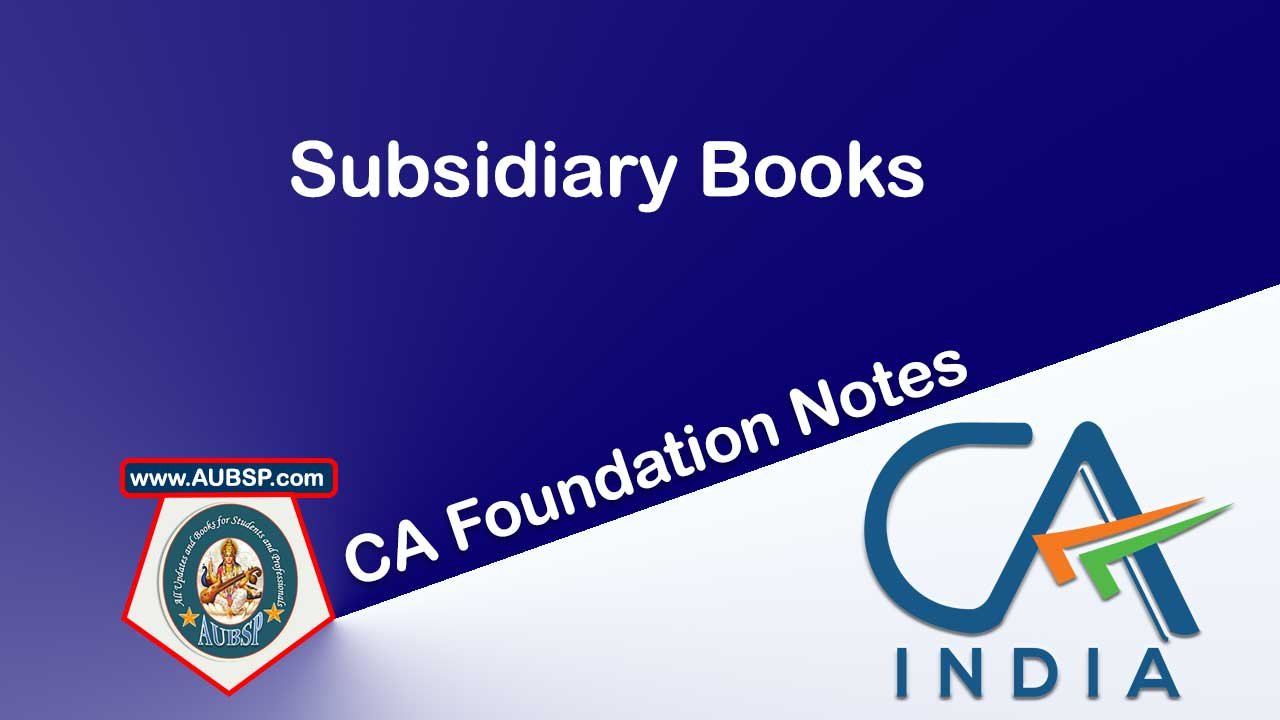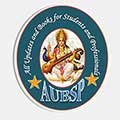Subsidiary books, also known as books of original or prime entry, are specialized accounting journals used to record specific types of transactions such as credit purchases, credit sales, returns, and bills. They include the Purchases Book, Sales Book, Purchase Returns Book, Sales Returns Book, Bills Receivable Book, Bills Payable Book, and Journal Proper.
These books streamline the recording process, ensure division of work, improve accuracy, and simplify error detection. While subsidiary books reduce reliance on the journal, the Journal Proper remains essential for non-routine transactions like asset purchases, adjusting entries, and rectifications. The use of these books supports efficient ledger posting and accurate financial reporting.
UNIT 4: SUBSIDIARY BOOKS – REVISION NOTES
Learning Objectives
- Understand how to record transactions in:
- Purchases Book
- Sales Book
- Returns Inward Book
- Returns Outward Book
- Bills Receivable/Payable Books
- Learn how to post from subsidiary books to the ledger.
- Recognize when journalisation is still required.
- Differentiate between subsidiary and principal books.
4.1 Introduction to Subsidiary Books
- Books of Original Entry / Prime Entry used for categorizing transactions.
- Also known as Subsidiary Books.
- Forms part of Practical/English system of bookkeeping.
- Uses double-entry principles.
Common Subsidiary Books:
- Cash Book – for cash/bank transactions.
- Purchases Book – for credit purchases of goods.
- Purchase Returns Book – for returns to suppliers.
- Sales Book – for credit sales.
- Sales Returns Book – for returns from customers.
- Bills Receivable Book – for received bills/promissory notes.
- Bills Payable Book – for issued bills/promissory notes.
- Journal Proper – for transactions not fitting above categories.
Advantages of Subsidiary Books
- Division of work – tasks can be shared among clerks.
- Specialization – enhances efficiency and accuracy.
- Saves time – parallel processing of entries.
- Easier to locate information – grouped by type.
- Error detection – easier due to segregation of records.
Difference: Subsidiary Books vs. Principal Books
| Feature | Subsidiary Books | Principal Books |
|---|---|---|
| Purpose | Initial recording of transactions | Final classification |
| Examples | Sales Book, Purchase Book | Ledger, Cash Book |
| Nature | Books of original entry | Books of final entry |
| Output | Input for Ledger | Source for Trial Balance |
Purchases Book
- Records credit purchases of goods only.
- Excludes:
- Cash purchases → go to Cash Book
- Credit purchase of assets (e.g., furniture) → go to Journal Proper
Format:
| Date | Particulars | Details | Amount |
|---|
Key Points:
- Trade discounts are deducted.
- Freight, packing charges added.
- Total posted to Purchases A/c (Dr).
- Suppliers’ A/c credited.
Sales Book
- Records credit sales of goods only.
- Excludes:
- Cash sales → go to Cash Book
- Credit sales of fixed assets → go to Journal Proper
Format:
| Date | Particulars | Details | Amount |
|---|
Posting:
- Total → Sales A/c (Cr)
- Customer accounts → Debited
Sales Returns Book (Returns Inward Book)
- For goods returned by customers.
- Credit notes issued to customers.
- Sales Returns A/c debited, customer A/c credited.
Purchase Returns Book (Returns Outward Book)
- For goods returned to suppliers.
- Debit notes sent to suppliers.
- Purchase Returns A/c credited, supplier A/c debited.
Bills Receivable & Payable Books
- Bills Receivable Book: for accepted promissory notes.
- Bills Payable Book: for bills issued to others.
- Used when such transactions are frequent.
Journal Proper
Used for entries not recorded in other subsidiary books:
Includes:
- Opening Entries
- Closing Entries
- Rectification Entries
- Transfer Entries
- Adjusting Entries:
- Outstanding/Prepaid Expenses
- Accrued/Unearned Incomes
- Interest on Capital
- Depreciation
- Dishonour of Bills
- Miscellaneous Entries:
- Purchase of fixed assets
- Bad debts
- Losses from accidents
- Net profit transfer to capital
Summary
- Subsidiary books streamline and organize recordkeeping.
- Essential for practical accounting and business operations.
- They reduce reliance on Journal, though Journal is still essential for non-standard entries.
Practice Questions – Key Answers
True or False:
- ✅ True
- ❌ False
- ❌ False
- ✅ True
- ✅ True
- ❌ False
- ❌ False
- ✅ True
- ✅ True
MCQs:
- (b) Credit purchase of goods dealt in
- (c) Return of goods sold
- (a) Part of journal
- (a) Debit of Purchases A/c
- (a) Credit of Sales A/c
- (b) Cash Book
- (a) Journal Proper
- (c) Journal Proper
FAQs on Subsidiary Books in Accounting
1. What are subsidiary books in accounting?
Subsidiary books are specialized journals used to record transactions of a specific nature before posting them to the ledger.
2. Why are subsidiary books also called books of original entry?
Because they are the first place where transactions are recorded before being transferred to the ledger.
3. What is the purpose of maintaining subsidiary books?
To classify and simplify the recording of business transactions, reduce errors, and allow for division of accounting work.
4. What is the difference between subsidiary books and principal books?
Subsidiary books are for initial recording; principal books (ledger, cash book) are for summarizing and preparing financial statements.
5. What are the main types of subsidiary books?
- Purchases Book
- Sales Book
- Purchases Returns Book
- Sales Returns Book
- Bills Receivable Book
- Bills Payable Book
- Journal Proper
6. What is recorded in the Purchases Book?
Only credit purchases of goods or raw materials.
7. Are cash purchases recorded in the Purchases Book?
No, they are recorded in the Cash Book.
8. What is entered in the Sales Book?
Only credit sales of goods the firm normally trades in.
9. Are cash sales included in the Sales Book?
No, they go into the Cash Book.
10. What is the Purchase Returns Book used for?
To record returns of goods previously purchased on credit.
11. What is the Sales Returns Book (Returns Inward Book)?
It records goods returned by customers that were sold on credit.
12. What is the Bills Receivable Book?
A record of all promissory notes/bills received from debtors.
13. What is the Bills Payable Book?
A record of bills/promissory notes issued to creditors.
14. What goes into the Journal Proper?
Non-standard or one-time transactions such as depreciation, asset purchase, adjustments, opening and closing entries, etc.
15. Is the Journal Proper a subsidiary book?
Yes, it is used for transactions not recorded in other subsidiary books.
16. Where is the purchase of fixed assets on credit recorded?
In the Journal Proper, not in the Purchases Book.
17. Where is the sale of furniture recorded?
In the Journal Proper (if sold on credit), not in the Sales Book.
18. What are opening entries?
Entries made at the beginning of a financial year to record opening balances.
19. What are closing entries?
Entries made at year-end to transfer balances from nominal accounts to the Profit & Loss Account.
20. What are rectification entries?
Entries passed to correct errors in books.
21. What are adjusting entries?
Entries to adjust outstanding, prepaid, accrued, or unearned amounts.
22. What are transfer entries?
Entries that shift amounts from one account to another.
23. What are dishonour entries in journals?
Entries recording the failure of a bill/promissory note to be honoured.
24. How are entries posted from subsidiary books to ledger?
Totals from books are posted to relevant accounts (e.g., Sales total → Sales A/c), and individual parties’ accounts are updated.
25. Are trade discounts shown in ledger?
No, only net amounts after trade discounts are recorded.
26. What is a credit note?
A document issued to a customer when goods are returned or overcharged.
27. What is a debit note?
A document sent to a supplier when returning goods purchased on credit.
28. Why use separate books for returns?
To simplify tracking and reduce errors related to goods returned.
29. Is the Cash Book a subsidiary book?
Technically no; it’s considered a principal book though it’s also a book of original entry.
30. Are all journal entries replaced by subsidiary books?
No, only regular or common transactions are moved to subsidiary books; other entries stay in the Journal Proper.
31. Is the Sales Book part of the ledger?
No, it’s part of the journal system.
32. What is the posting date in the ledger for subsidiary books?
Usually at the end of the period (weekly or monthly).
33. Can a transaction be in more than one subsidiary book?
No, each transaction type belongs in only one specific book.
34. How is trade discount treated in books?
Deducted before recording the transaction; not entered separately.
35. Why aren’t cash transactions in the sales/purchase books?
Because they belong in the Cash Book, not the credit-oriented subsidiary books.
36. What is the format of the Sales/Purchase Book?
Date | Particulars | Details | Amount
Subsidiary books are essential tools in the accounting process that enhance accuracy, efficiency, and clarity by systematically categorizing routine transactions. They serve as the first step in the recording process, helping businesses manage large volumes of data with ease by segregating entries into specific books such as Purchases, Sales, Returns, and Bills.
While they reduce the load on the general journal, the Journal Proper remains vital for recording unique or infrequent transactions. Mastery of subsidiary books not only simplifies ledger posting but also ensures a firm foundation for preparing accurate financial statements. Understanding their purpose, format, and use is crucial for any aspiring accountant or commerce student.



Leave a Reply
You must be logged in to post a comment.